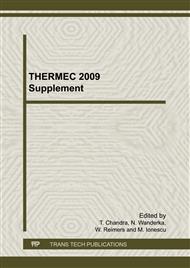p.703
p.709
p.715
p.721
p.727
p.733
p.739
p.745
p.751
Water-Resistant Poly(Vinyl Alcohol) Hybrid Nanofibers Incorporating Polyhedral Oligosilsesquioxane (POSS)
Abstract:
We have explored a straightforward approach for achieving water-resistant properties of the electrospun PVA nanofibers. The electrospun PVA nanofibers are post-treated with a hydrophobic polyhedral oligosilsesquioxane (POSS) hybrid macromer via a direct urethane reaction between the hydroxyl group of PVA and the isocyanate group of POSS macromers. The POSS-modified PVA nanofibers are characterized by fourier transform infrared spectroscopy (FT-IR), scanning electron microscopy (SEM), thermogravimetric analysis (TGA), and water resistant property. The morphologies of the electrospun PVA nanofibers before and after POSS post-treatments are regular and a narrow distribution of diameters was observed, indicating a uniform post-treatment of POSS macromers onto the PVA nanofibers. Thermal decomposition behavior of the POSS-modified PVA nanofibers was altered compared to the pure PVA nanofibers, suggesting the suppression of thermal decomposition due to the incorporation of POSS macromers. In addition, the pure PVA nanofiber mats immersed in pure water exhibited no characteristic morphology, whereas the POSS-modified PVA nanofiber mats showed the texture morphology, indicating an enhanced water-resistant property.
Info:
Periodical:
Pages:
727-732
Citation:
Online since:
January 2010
Authors:
Price:
Сopyright:
© 2010 Trans Tech Publications Ltd. All Rights Reserved
Share:
Citation:


